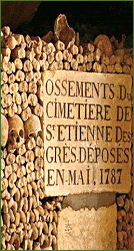The Catacombs of Paris is a famous burial place in Paris, France. It is a network of subterranean tunnels and rooms located in what were Roman-era limestone quarries.
The quarries were converted into a mass tomb near the end of the 18th century. It is home to more than six million Parisians for whom the Catacombs have become a final resting place.
It is most widely known as "the catacombs", but the official title is "les carrières de Paris" or "the quarries of Paris."
Though the official tour only passes through the quarries in the 14th arrondissement, there are actually quarries in the 5th, 6th, 12th, 13th, 14th, 15th, and 16th arrondissements (the municipal boroughs of Paris).
Source: Wikipedia. Catacombs of Paris.
 | |||||||||||||
| |||||||||||||
Trips
Far beneath the city streets of Paris lies the bone remains of more than 6 million people, in an elaborate labyrinth of passages, tunnels and corridors. It is a place of mystery, of intrigue, of history and of death.
One can easily get lost or disoriented when exploring the Parisian Catacombs and become one with the remains of those who are already there.
 It's a place that people visit to get scared--a perfect spooky location for a Halloween scare or a different type of a vacation.
It's a place that people visit to get scared--a perfect spooky location for a Halloween scare or a different type of a vacation.
This lens explores the mysteries of the catacombs in Paris and Rome, the cataphiles and some of the more notable inhabitants and probable inhabitants.
You can also learn about the cataphiles or catacomb explorers.
Contents at a Glance
Far beneath the city streets of Paris lies the bone remains of more than 6 million people, in an elaborate labyrinth of passages, tunnels and corridors. It is a place of mystery, of intrigue, of history and of death.
One can easily get lost or disoriented when exploring the Parisian Catacombs and become one with the remains of those who are already there.
 It's a place that people visit to get scared--a perfect spooky location for a Halloween scare or a different type of a vacation.
It's a place that people visit to get scared--a perfect spooky location for a Halloween scare or a different type of a vacation.This lens explores the mysteries of the catacombs in Paris and Rome, the cataphiles and some of the more notable inhabitants and probable inhabitants.
You can also learn about the cataphiles or catacomb explorers.
Contents at a Glance
The Catacombs from Wikipedia
 The original catacombs are a network of underground burial galleries beneath San Sebastiano fuori le mura, in Rome. The derivation of the word itself is disputed and it remains unclear if it ultimately derives from the cemetery itself or from the locality in which it is found.
The original catacombs are a network of underground burial galleries beneath San Sebastiano fuori le mura, in Rome. The derivation of the word itself is disputed and it remains unclear if it ultimately derives from the cemetery itself or from the locality in which it is found.There is no doubt however that the San Sebastiano catacombs are the first to be referred to as such.
The word now refers to any network of caves, grottos, or subterranean place that is used for the burial of the dead, or it can refer to a specific underground burial place.
Source: Wikipedia. The Catacombs.
Catacombs - Defined
 Catacombs are a subterranean place, chamber or tunnels used for the burial of the dead.
Catacombs are a subterranean place, chamber or tunnels used for the burial of the dead.Catacombs is an underground cemetery, with tunnels and chambers with places for graves an underground tunnel. Many contained recesses where bodies were buried.
A Collection of Catacomb Images on Flickr
A collection of photographs on various catacombs around the world used under Creative Commons License. Photos by Sebastian Bergmann, secretagentmoof, NatalieMaynor, AlphaTangoBravo, moonlightbulb and watchsmart
Sections of this Catacomb Lens
Sections of this Catacomb Lens
A list of the sections of the Catacombs Lens.
- Catacombs in Paris
- Cataphiles - Lovers of Catacombs
- Catacombs in Rome
- Catacombs of Palermo
- Phantom of the Opera
- Gregorian Masters of Chant
- Skulls and Skeletons Decorating the Sedlec Ossuary








0 comments: